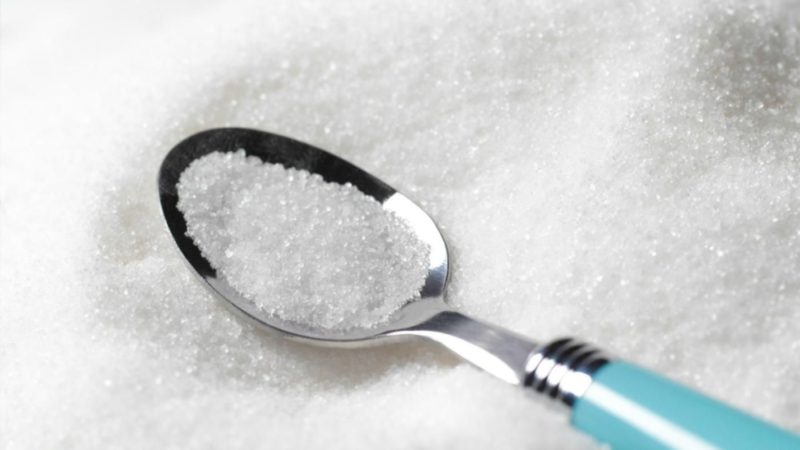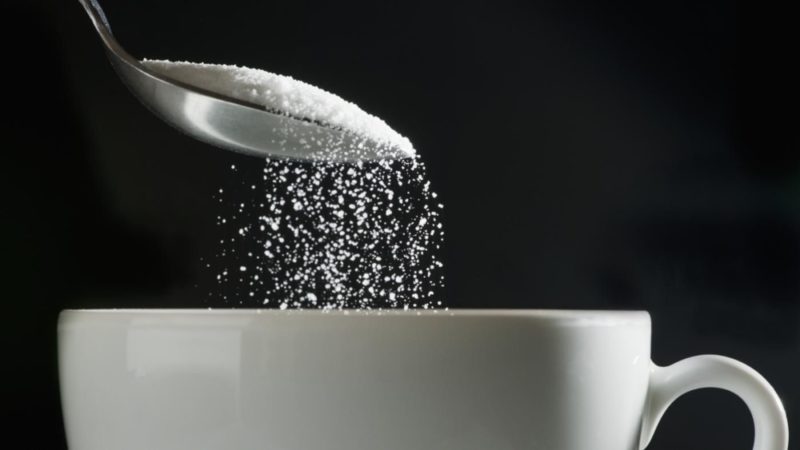Sugar is made from different plants: beets, cane, corn, even grapes and pumpkins. It is necessary for man, like a car fuel. Some scientists call it "white death." What is the truth? The human body will not last long without it - this is definitely known. But how much it can be eaten, and how many calories in a teaspoon of sugar is a question that worries many.
Material Content:
Chemical composition and nutritional value
Sugar is pure sucrose present in fruits and berries. Most of it is found in sugarcane and beets. Industrial production is based precisely on these plants.
99% of the product under discussion are mono- and disaccharides. 1% - water, iron, sodium, calcium.
Talking about it, we represent a loose substance of white color, or refined cubes.
In fact, the product is divided into three groups:
- sand, or granular;
- refined lumpy;
- brown.
The main types include:
- Regular sugar - found in any home, it is used for various purposes.
- Fruit - represents small crystals of the same size. Used in the manufacture of dry drinks, puddings.
- Pekarsky - used by professional confectioners.
- Ultrafine - soluble in any liquid. Sold in England under the name Caster.
- Powdered sugar - ground sugar with the addition of about 3% of corn starch.
- Coarse - large crystals, at high temperatures they do not break down into glucose and fructose. Used for the manufacture of confectionery.
- Sprinkling - its structure gives cakes and pastries an attractive sparkle.
There is also sugar called brown, which is little known in our country. It is divided into several types: demarra, soft and muscovado. It is obtained from raw cane juice. It hardly differs in quality indicators from our white one, but it costs several times more. Some unscrupulous manufacturers have learned to tint a regular product, while increasing its price.
Calorie content and BJU of a teaspoon of sugar
- The energy value of 100 grams is 399 kcal.
- Protein - 0.00 g, fat - 0.00 g, carbohydrates - 53.28 g.
- The calorie content of 1 teaspoon of sugar with a slide is 28 - 31.9 kcal, without the top - 15 kcal.
The content of vitamins and minerals
These substances are contained in any form of the product under discussion in small quantities. It also has no fat-soluble vitamins. Only water soluble B2.
There are also not many trace elements in 100 g:
- calcium - 1.0 mg;
- iron - 0.1 mg;
- potassium - 2.0 mg;
- sodium - 1.0 mg;
- selenium - 0.6 mcg.
The rate of consumption of the product per day
According to WHO standards, men can consume up to 9 teaspoons of granulated sugar per day, women - 6.
At the same time, its quantity should be considered not only in drinks or eaten dishes, but in all food per day. A glass of soda and a piece of cake or a chocolate bar can meet the entire daily intake.
Residents of Russia eat 100 g of product per day, and Americans - 190 g.
Benefits and harm to the body
Carbohydrate, which is easily absorbed and has the highest calorie content, energizes. Under the influence of enzymes, sucrose is broken down into monosaccharides, which are involved in the production of many substances and hormones important for the body. This is a plus.
In addition, other useful qualities of the product are known:
- Without it, the human body cannot function normally. It helps to improve blood circulation in the brain and spinal cord.
- Prevents the formation of atherosclerotic plaques and blood clots in the vessels. Most often, patients who do not like sweets suffer from arthritis.
- Restores the barrier function of the liver. A diet with an increased amount of sugar consumption is recommended for liver pathologies and poisoning.
- Makes people happier, improves mood.
The downside is that an increase in daily intake can lead to obesity, a deficiency of calcium and minerals in the body, the development of problems with teeth, in particular caries.
It has become fashionable to replace a natural product with artificial sweeteners. There was an opinion that this helps in the fight against excess weight. But this is not so.
When sugar enters, the process of insulin production begins to activate. In the case of natural, the level of glucose in the blood decreases. When taking sweeteners, a person does not receive the required amount of carbohydrates, insulin is not consumed, and fat reserves increase.
There are also substitutes for natural origin: sorbitol, xylitol, fructose. They are very high in calories and for this reason will not become assistants in the fight against excess weight.
Exceptions include stevia. It has no calories and does not increase blood glucose.
Real honey is the best substitute. It is useful and safe: it contains vitamins and minerals. In addition, it strengthens the immune system.
Sugar has positive and negative qualities. The main thing is not to overdo it with sweets and then no obesity threatens you.















